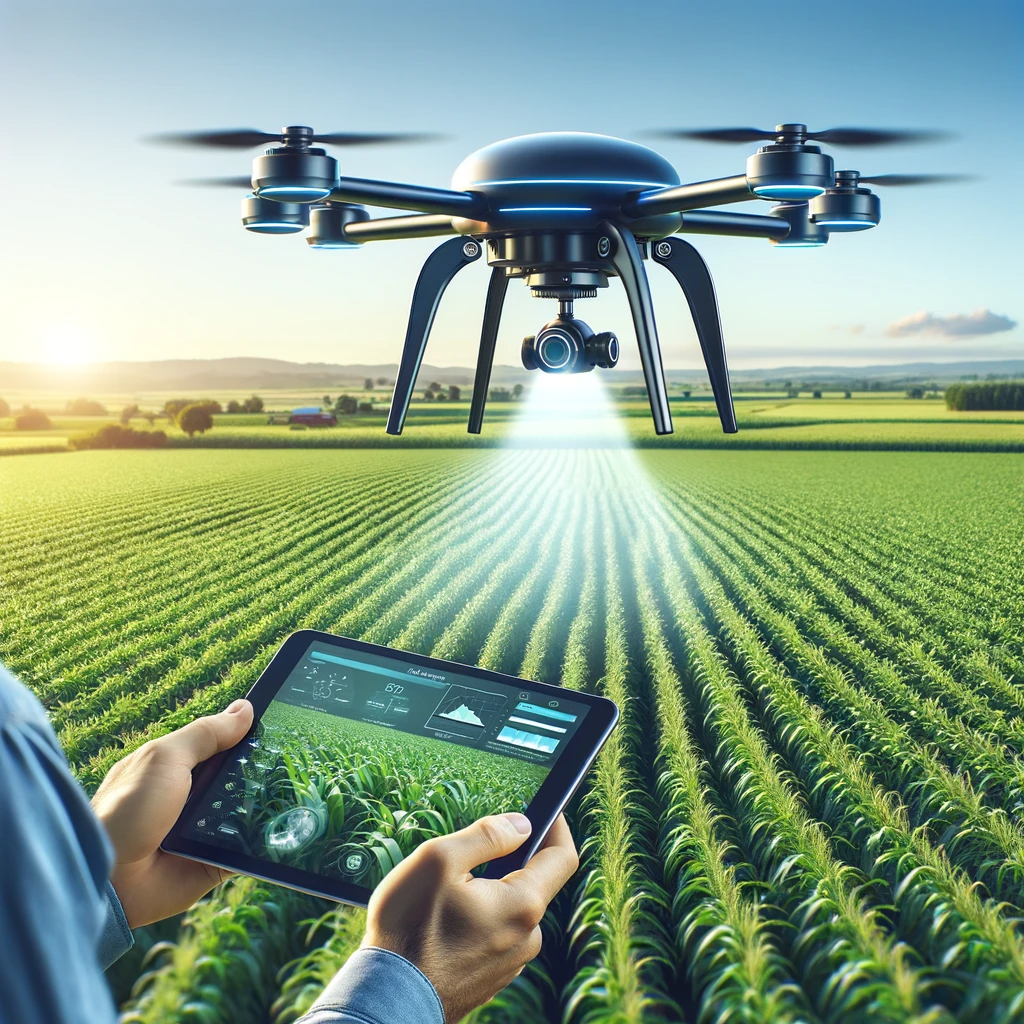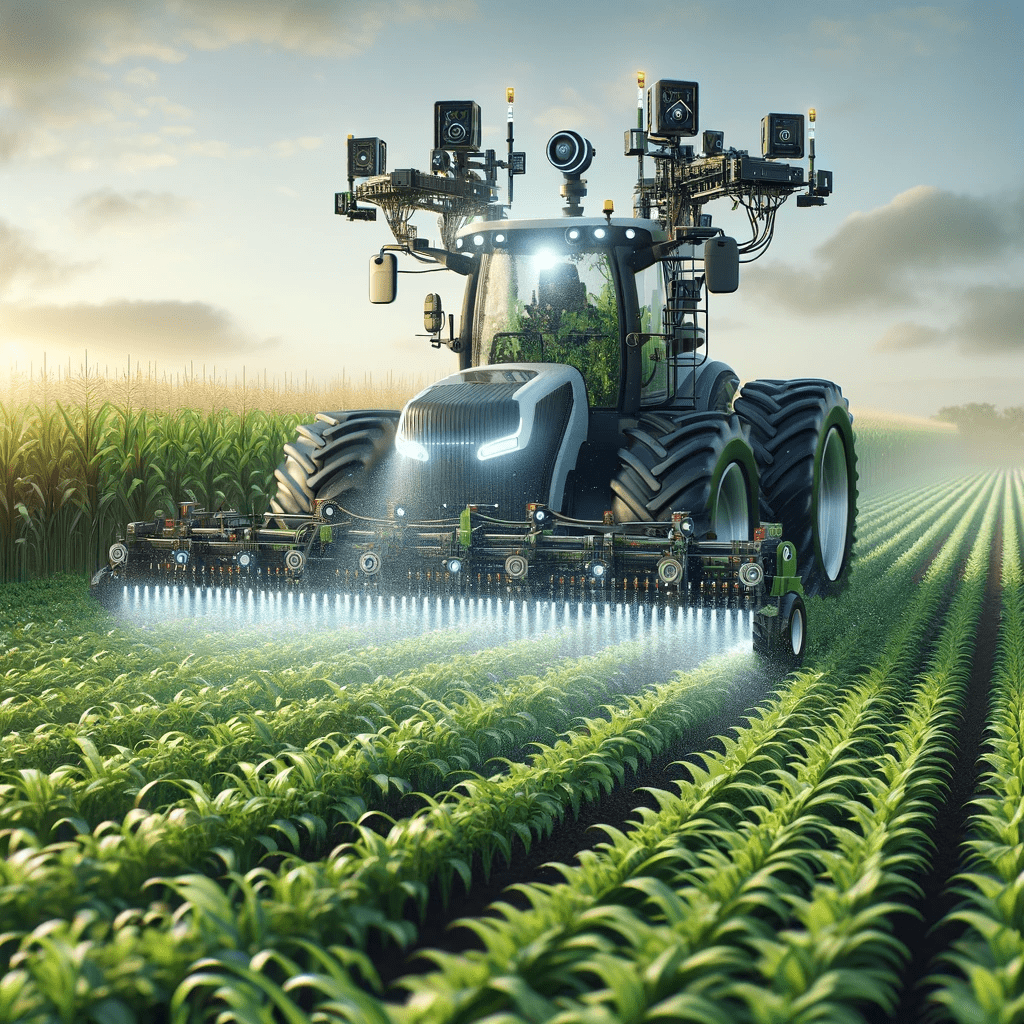Machine Vision in Agriculture
In the realm of agriculture, the integration of technology has revolutionised the way farming is conducted. One of the most significant advancements is the development of machine vision platforms coupled with artificial intelligence (AI) algorithms for the detection of agricultural produce.
This machine vision technology not only promises to increase efficiency and yield of fruits and vegetables but also aims to reduce the environmental footprint of farming, ensuring sustainability and food security for future generations. This article delves into the mechanics of these systems, their applications, benefits, challenges, and future prospects. Ready for your first vision application?
Understanding AI Vision
AI vision refers to the technology and methods used to provide imaging-based automatic inspection, process control, and robot guidance in industrial applications. In agriculture, machine vision platforms are designed to mimic human visual perception, enabling machines to detect, identify, and classify objects. These systems typically consist of a stereo camera, digital processing, control units and often include computer vision applications. The cameras capture images of the crops, which are then processed by software to extract necessary information.
Role of Artificial Intelligence Computer Vision
Artificial intelligence and machine vision play a crucial role in interpreting the data collected about plant health. AI algorithms, particularly machine learning and deep learning models, are trained on vast datasets to recognize patterns and make decisions. In the context of these algorithms analyze the visual data to distinguish healthy, ripe produce from diseased or unripe ones, identify weeds, and make real-time decisions about gathering crops. The integration of Artificial Intelligence (AI) in the agriculture industry represents a significant leap forward in how we approach farming and food production. This integration is part of a broader trend known as “Agriculture 4.0,” which aligns with the fourth industrial revolution’s focus on smart technologies. Here’s an introduction to how AI is transforming the agriculture industry.
Agriculture 4.0 computer vision
Agriculture 4.0 refers to the modernization of the agricultural sector through the integration of advanced digital technologies, a concept that aligns with the Fourth Industrial Revolution (Industry 4.0). This revolution in agriculture involves the use of big data, the Internet of Things (IoT), artificial intelligence (AI), robotics, and other emerging technologies to create more efficient, sustainable, and productive farming practices.
Key Components of Agriculture 4.0
- Internet of Things (IoT): IoT devices such as sensors, drones, and GPS systems are used extensively in Agriculture 4.0. They collect data on crop conditions, soil quality, weather, and more, enabling precise farming practices.
- Big Data and Analytics: The vast amount of data generated by IoT devices is analyzed using big data analytics. This analysis helps in making informed decisions, predicting trends, and optimizing resources.
- Artificial Intelligence and Machine Learning: AI and machine learning algorithms process data to provide insights for crop management, pest control, yield prediction, and risk assessment, enhancing decision-making and operational efficiency.
- Robotics and Automation: Robotics and automated machinery play a crucial role in planting, harvesting, weeding, and spraying, reducing manual labor and increasing precision.
- Remote Sensing Technology: This includes the use of satellites and drones for monitoring large agricultural areas, providing valuable data on crop health, soil conditions, and environmental factors.
- Blockchain Technology: Blockchain is used for supply chain management in agriculture, ensuring traceability, transparency, and improved logistics from farm to consumer.
Applications machine vision for Agriculture
- Precision Agriculture: AI enables farmers to make more informed decisions by analyzing data from various sources like satellite images, sensors, and weather forecasts. This approach, known as precision agriculture, allows for more efficient use of resources such as water, fertilizers, and pesticides.
- Crop Monitoring and Management: AI-driven technologies like drones and satellites can monitor crop health, soil conditions, and environmental factors. Machine learning algorithms can process this data to detect plant diseases, pest infestations, or nutrient deficiencies early on.
- Predictive AnalyticsIn 2023: AI, with the help of machine vision application, can predict crop yields by analyzing historical data, which helps in better planning and supply chain management of fruits and vegetables. It can also forecast potential outbreaks of diseases or pests, allowing for proactive measures.
- Automated Machinery: Autonomous or semi-autonomous tractors, harvesters, and drones reduce the need for manual labor and increase efficiency. These machines can be programmed to perform tasks like planting, weeding, and harvesting.
- Livestock Management: AI is used in monitoring the health and well-being of livestock. Sensors can track movement, feeding patterns, and signs of illness, enabling early intervention and better herd management.
- Resource Management: AI helps in efficient water usage and soil management, crucial in areas facing water scarcity and declining soil health. Smart irrigation systems use vision-based AI to optimize water usage based on weather predictions, soil moisture levels, and plant health.
- Supply Chain Optimization: AI enhances the agriculture supply chain by improving demand forecasting, reducing waste, and ensuring fresher produce reaches consumers. Using machine vision, it can also trace fruits and vegetables from farm to table, ensuring transparency and food safety.
Benefits of Integrating AI in agriculture industry
- Increased efficiency and productivity are benefits of the vision-based systems that are transforming the agriculture industry.: Automated systems can operate round the clock and process information much faster than humans, leading to increased productivity.
- Reduced Labor Costs: Automation reduces the reliance on manual labor, which is particularly beneficial in regions facing labor shortages.
- Enhanced Quality and Yield: Precise and timely harv ensures that only the best produce reaches the market, enhancing quality. Early detection of diseases and pests leads to healthier crops and better yields.
- Sustainable Farming PracticesBy 2023: Targeted application of herbicides and optimal usage of resources will contribute to sustainable and environmentally friendly farming practices, thanks to the role that vision is playing in the transformation.
Challenges and Considerations
- High Initial Investment: The cost of advanced AI and machine vision platforms can be prohibitive for small-scale farmers.
- Technical Complexity: Implementing and maintaining such sophisticated systems require technical expertise, which may not be readily available.
- Data Privacy and Security: As with any AI system, there are concerns about the privacy and security of the data collected.
- Adaptability and Flexibility: Agricultural environments are highly variable. Systems need to be robust and adaptable to different crops, weather conditions, and terrains.
The Future of Computer Vision and AI in Agriculture
The potential of machine vision, vision-based AI, and imaging in agriculture is vast, thus set to revolutionize plant health by 2023. Ongoing research is focused on improving the accuracy, efficiency, and affordability of these systems. Future developments might include more sophisticated algorithms capable of handling more complex tasks, integration with other technologies such as drones and IoT devices, and more user-friendly interfaces for farmers.

Conclusion
The convergence of machine vision platforms and artificial intelligence algorithms is setting the stage for a new era in agriculture. While challenges remain, the benefits—increased efficiency, reduced environmental impact, and higher quality produce—are driving the adoption of this technology. As we continue to refine and improve these systems, they will undoubtedly play a crucial role in shaping the future of sustainable agriculture. The journey from traditional farming to smart agriculture using computer vision and IoT devices is well underway, promising a future where technology and tradition work hand in hand in farming of fruits and vegetables.
What is machine vision in agriculture?
A: Machine vision in agriculture refers to the use of computer vision systems and technology to automate and enhance various processes in the agricultural industry, such as planting, harvesting, quality control, and monitoring of crops and livestock.
What are the applications of computer vision in agriculture?
A: Computer vision in agriculture has various applications, including precision agriculture, object detection, robotic harvesting, multispectral imaging for crop health monitoring, quality control in food production, and livestock monitoring and management.
How will machine vision and AI impact the future of agriculture?
A: Machine vision and AI are expected to revolutionize agriculture by enabling automation of repetitive tasks, optimizing resource usage, improving crop yield and quality, enhancing livestock management, and enabling data-driven decision making for farmers and agribusinesses.
What are the key components of a machine vision system for agriculture?
A: A machine vision system for agriculture typically includes sensors, vision cameras, neural networks for image processing, robotic platforms, and specialized software for data analysis and decision support in agricultural operations.
How does computer vision technology contribute to automation in agriculture?
A: Computer vision technology enables automation in agriculture by providing real-time monitoring and analysis of crops, soil, and livestock, guiding autonomous vehicles for planting and harvesting, and facilitating the implementation of precision agriculture techniques for optimized resource utilization.
What are the benefits of using machine vision systems in agriculture?
A: Using machine vision systems in agriculture results in improved efficiency, higher productivity, reduced labor costs, enhanced crop and livestock management, increased crop quality, and the ability to make data-driven decisions to optimize farming operations.
How is aerial machine vision used in agriculture?
A: Aerial machine vision is utilized in agriculture for tasks such as crop monitoring, field mapping, pest and disease detection, and assessing crop health from above using drones and other aerial platforms equipped with vision systems and sensors.
What role does computer vision play in the greenhouse industry?
A: Computer vision plays a crucial role in the greenhouse industry by enabling monitoring and control of environmental parameters, automated plant disease detection, optimizing crop growth conditions, and integrating with robotic systems for greenhouse operations.
What are some use cases of computer vision techniques in livestock farming?
A: Computer vision techniques are used in livestock farming for tasks such as animal behavior monitoring, automated feeding and milking systems, health monitoring, and implementing precision livestock management practices for improved productivity and animal welfare.
How is machine vision technology applied to quality control in agriculture?
A: Machine vision technology is applied to quality control in agriculture by inspecting and sorting produce, identifying defects, assessing ripeness, and ensuring product quality and consistency through automated visual inspection systems integrated into food processing and packaging facilities.

